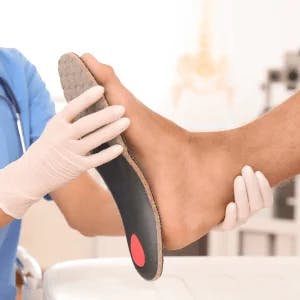A poorly trimmed toenail can quickly turn into a troublesome problem. Toenail care may seem simple, but when done improperly, it can lead to discomfort. If you’ve ever had an ingrown toenail, you know how agonizing and frustrating it can be. Trimming your nails too short or at the wrong angle can cause redness, swelling, and even infection.
Let’s go over what an ingrown toenail is, how to recognize the symptoms, and most importantly, how to cut your toenails the right way to avoid this painful problem.
What is an ingrown toenail?
An ingrown toenail occurs when the edge of the nail grows into the surrounding skin instead of straight out. This typically affects the big toe, but can happen to any toenail. Improper nail trimming, tight shoes, or even genetics can also contribute to the problem. While mild cases can be treated at home, severe ingrown toenails may require medical attention.
Ingrown toenail symptoms
If you suspect an ingrown toenail, but aren’t sure what to look for, here are a few signs:
- Pain and tenderness along the side of the toenail.
- Redness and swelling near the affected nail.
- Hardened or thickened skin around the nail.
- Drainage or pus, which could indicate an infection.
For ingrown toenails especially, the earlier you realize you’ve got an ingrown toenail the better, as they can progress rather quickly and can become extremely painful once they’ve grown too far into the toe.
Now, let’s discuss the right way to cut your toenails to keep them healthy.
How to cut a toenail to avoid ingrown
Proper nail-cutting techniques can go a long way when it comes to preventing ingrown toenails. Follow these steps for healthier nails and pain-free feet.
1) Choose the right tools
Instead, use sharp, high-quality toenail clippers or nail scissors to achieve a clean cut. For smoothing rough edges, a nail file or emery board works best. If your nails are particularly thick, consider using a toenail nipper for better precision.
- Sharp, straight-edge toenail clippers (not curved or fingernail clippers).
- A nail file to smooth rough edges.
- Nail scissors for minor shaping if needed.
2) Don't cut too close to the skin
If you cut your toenails too short, it increases the risk of the nail growing into the skin. For this reason, you’ll want to leave a little length—about 1-2 millimeters beyond the nail bed—to help the nail grow correctly.
3) Avoid rounding
While rounded nails may look neater, curving the edges of your toenails encourages them to grow into the surrounding skin. Instead, trim straight across and use a nail file to smooth out sharp edges.
4) Cutting frequency
Toenails grow more slowly than fingernails, so you don’t need to trim them as frequently. Aim for every two to three weeks, depending on your growth rate. If toenails grow too long, they can press against your shoes and cause discomfort, while trimming them too often may lead to irritation and sensitivity.
5) Check for signs of ingrown toenails
After trimming, inspect your nails and toes for any early signs of an ingrown nail, such as redness, tenderness, or swelling. If you notice discomfort, avoid applying pressure to the area and monitor for any worsening symptoms.
How to treat an ingrown toenail
If you have a mild ingrown toenail, at-home care may help. Here are a few ways that should, at the very least, reduce the pain of your symptoms:
- Soak your feet in warm, soapy water for 15-20 minutes, 2-3 times a day.
- Gently lift the nail edge with a small piece of cotton or dental floss.
- Apply antibiotic ointment to reduce the risk of infection.
- Wear loose-fitting shoes to relieve pressure on the toe.
However, if the pain worsens, the area becomes infected, or at-home treatments don’t help, we advise you to seek professional care.
Ingrown toenail treatment at CLS Health
If an ingrown toenail isn't improving with home care, professional treatment may be necessary to prevent infection or further complications. A podiatrist can safely trim or remove the affected portion of the nail, relieve discomfort, and provide guidance on proper nail care to reduce the risk of recurrence. Ultimately, it’s important to seek timely care to ensure the nail heals appropriately and minimize the risk of long-term problems.





